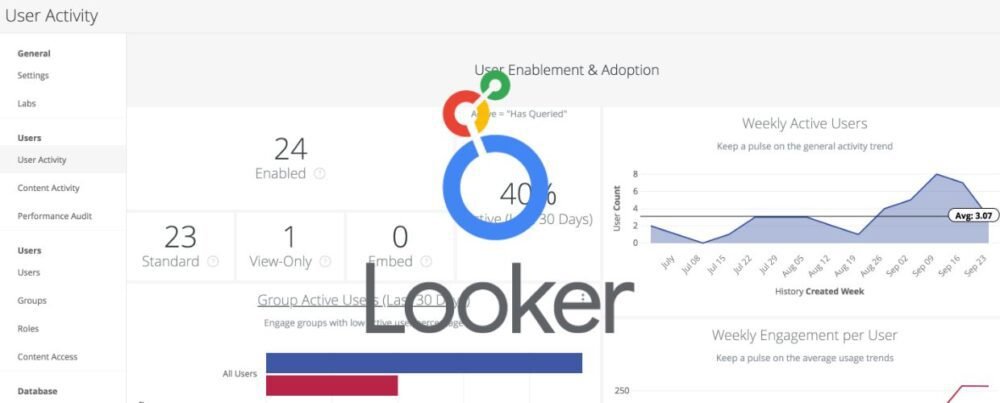In today’s data-driven world, organizations constantly seek innovative solutions to extract meaningful insights from their vast amounts of data. This article comprehensively analyzes Looker, highlighting its features, benefits, and impact on the business intelligence landscape.
What is Looker?
Looker, a powerful business intelligence and data exploration platform, has emerged as a frontrunner in this domain. It stands out from traditional business intelligence tools due to its unique approach to data exploration. Unlike conventional query-based systems, Looker adopts a model-driven architecture.
It builds a centralized semantic model, LookML, which acts as a single source of truth for the organization’s data. This model provides a consistent and understandable representation of the data, enabling users to explore and analyze information across various dimensions easily.
Recommendations and Ratings
EXPERT RECOMMENDATIONS
Overall
-
Easy-of-Use - 90
-
Feature and Functionality - 90
-
Customer Support - 90
-
Setup and Integration - 80
-
Value of Money - 90
User Review
4.64 (22 votes)User Interface and Collaborative Environment
One of its key strengths lies in its intuitive user interface, which empowers users of all technical backgrounds to perform complex data analysis tasks. The platform offers a visually appealing and interactive experience with drag-and-drop functionality and dynamic visualizations. Users can create and customize dashboards, reports, and charts effortlessly, allowing for effective data storytelling.
Another distinguishing feature of Looker is its emphasis on collaboration and data governance. With LookML, the centralized modeling language, organizations can ensure data consistency and maintain a single version of the truth across teams. Its collaborative functionalities, such as data sharing, annotations, and permissions, foster teamwork and enable seamless knowledge sharing within the organization.
Robust Analytics Capabilities
It offers a wide array of powerful analytics capabilities that enable users to derive meaningful insights from their data. It supports a range of data exploration techniques, including drill-down, filtering, and pivoting, to dive deep into datasets. The BI software solution also provides advanced features such as predictive analytics, anomaly detection, and machine learning integrations, enabling organizations to unlock predictive and prescriptive insights.
Cloud-Native and Scalable
Its cloud-native architecture offers significant advantages in terms of scalability and flexibility. The platform seamlessly integrates with popular data sources on-premises and in the cloud, making it suitable for organizations of all sizes. Looker’s scalable infrastructure ensures that users can analyze large volumes of data efficiently, empowering them to make data-driven decisions quickly.
Integration and Customization
Looker provides extensive integration capabilities, allowing users to connect with various data sources, databases, and other business tools. It seamlessly integrates with popular cloud platforms like Google Cloud Platform, Amazon Web Services, and Microsoft Azure, enabling users to leverage their existing technology stack. Moreover, it offers an open API and SDKs, facilitating custom integrations and the development of tailored solutions.
Benefits of Looker
With its intuitive interface, robust analytics capabilities, and emphasis on collaboration, Looker is revolutionizing how businesses approach data analysis. The adoption of Looker brings several key benefits to organizations.
Enhanced Data Exploration
It empowers users to explore and analyze data in a self-service manner, reducing dependency on data analysts and accelerating the decision-making process.
Improved Collaboration
Looker’s collaborative features foster a data-driven culture by enabling teams to share insights, collaborate on analyses, and align their strategies based on accurate and up-to-date information.
Increased Efficiency
With its intuitive interface and automation capabilities, organizations can streamline their data analysis workflows, reducing the time spent on manual data preparation tasks.
Actionable Insights
Looker’s advanced analytics capabilities, including predictive analytics and machine learning, enable organizations to uncover hidden patterns and trends in their data, facilitating proactive decision-making.
Scalability and Cost-Effectiveness
Its cloud-native architecture allows organizations to scale their analytics infrastructure as their data volume grows, eliminating the need for significant upfront investments in hardware and software.
Conclusion
Looker has emerged as a game-changer in data exploration and analytics. Its intuitive interface, robust analytics capabilities, collaborative environment, and seamless integration options make it ideal for organizations looking to extract meaningful insights from their data. By democratizing data analysis and fostering a culture of data-driven decision-making, the BI solution empowers organizations to stay ahead in today’s competitive landscape. As businesses continue to embrace the power of data, Looker remains at the forefront, enabling them to unlock the true potential of their information assets.











